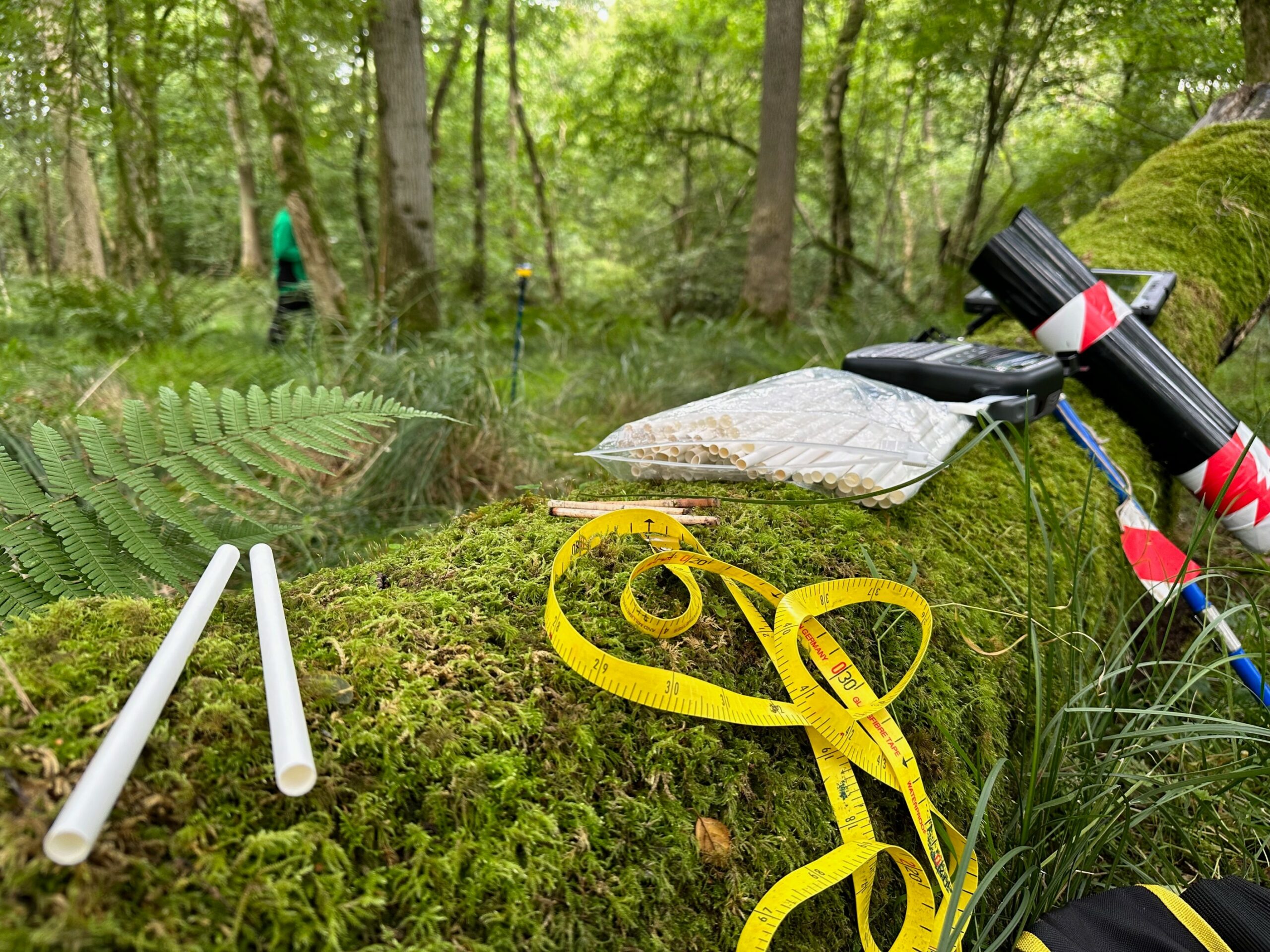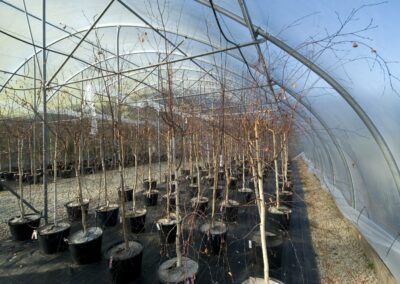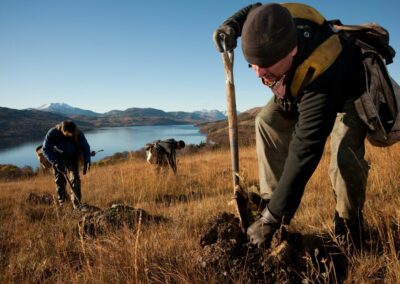Enhancing forest resilience through stand structural complexity
Project leads Dr Tom Ovenden; Dr Rubén Manso | Forest Research
Lead organisation Forest Research
Collaborators Bangor University; University of Bristol; The James Hutton Institute; Forestry England
Project status Active
Project funding 25-26 £282,042
Research outcomes Reducing the risk | Adaptation | Recovery
Context
As our climate warms, the duration, frequency, and intensity of extreme drought events is predicted to increase. Many of these changes are already underway, with 2018 and 2022 being amongst the hottest UK droughts on record. As a result, understanding how we can operationalise and integrate resilience concepts into sustainable forest management, particularly through the structural diversification of species-poor and structurally simple planted forests is key.
Forest managers broadly have two tools at their disposal to increase forest resilience and adapt to climate change: species choice and silviculture. While diversifying species composition is often promoted to increase resilience, relationships between species diversity and drought resilience are complex and highly context specific.
In contrast to species diversification, relationships between forest structure and resilience have received remarkably little attention, despite a rich and diverse literature linking forest structure with ecosystem function. This project aims to unpack some of the largely untapped potential of forest structural diversification to increase forest resilience, particularly to drought.
Research aims and objectives
Aim:
Combine remote sensing, dendrochronology, silviculture, social science and timber properties research to provide a holistic understanding of the following:
Objectives:
Are more structurally diverse forests also more drought resilient?
- Technological advances means we can now fire millions of lasers into the forest every second and use the data from these lasers (LiDAR) to reconstruct a high resolution 3D computer image of the forest. This 3D image can then help us understand how structurally diverse forests are to one another. By collecting tree cores from the same trees, we can look back in time to see how the forest grew and developed, how these trees have responded to drought and critically, how this response changed depending on the the structure of the forest they were growing in.
Can forest management (e.g. silviculture) be harnessed to increase drought resilience?
- Using the same LiDAR and tree core data collected from different forest experiments that have been thinned in different ways, i.e. the systematic removal of some trees to promote the growth of remaining trees, we want to understand if thinning before a drought promotes greater drought resistance, or whether thinning immediately after a drought might encourage faster post-drought recovery.
What do forest managers consider to be the barriers and opportunities to increasing forest structural complexity?
- Walking interviews with forest managers who have experience of managing forests for structural diversity across three sites in England, Wales and Scotland will increase are understanding of the barriers and opportunities related to wider uptake of these management practices. A later workshop will use three dimensional images as a prompt for cross-sectoral and systems-based discussion of the same topic.
What are the implications of diversifying forest structure for timber quality?
- Silvicultural approaches used to increase structural complexity often lead to diverse competition environments that affect growth rates in a number of ways. Changes in growth rates at different ages can in turn have a positive or negative impact on the wood properties that determine the strength class, i.e. quality, of timber aimed at structural use. Through different non-destructive methods, we will measure two of these properties (wood density and stiffness) in complex stands to understand what those impacts are. The aim is to shed light on the implications of Continuous Cover Forestry (CCF) on structural timber.
Expected outcomes
- Build a foundational understanding of the relationships between forest structure and drought tolerance, particularly in productive conifers (Pinophyta).
- Lay the groundwork for a new suite of silvicultural tools for climate change adaptation.
- Contribute to building a dataset of wood properties in commercial forests that diverge from the current Sitka spruce (Picea sitchensis) paradigm.
- Compile structural information that can be related to wood properties.
- Develop a greater understanding of the barriers and opportunities to the wider uptake of structurally complex forests and the silvicultural techniques to achieve these.
- Year 1 outputs will include a report, academic articles, short form deliverables such as a briefing note and blogs, and wider engagement events such as webinars and conference presentations.
Dendrochronology analysis equipment.
Title image: Crown Copyright. Forest Research – Tom Ovenden Body image: Crown Copyright. Forest Research – Tom Ovenden
Glossary & Key Terms
Conifer (Pinophyta)
Conifers, or softwood trees, are cone-bearing and usually evergreen trees. They are a distinct group of trees that are economically significant due to their ability to grow quickly even on poor soils and in harsh climates. These trees yield timber that is highly suitable for industrial use, which has led to their widespread planting and management across many countries. Examples of conifer trees found in the UK include Scots pine, Douglas fir, and Norway spruce.
Continuous Cover Forestry (CCF)
A woodland management approach that involves selectively thinning trees to create a diverse forest structure, whilst maintaining canopy cover.
Dendrochronology
Dendrochronology, also known as tree ring analysis, is the scientific method of dating based on the analysis of patterns of tree rings. These rings, formed annually, reflect variations in climate and environmental conditions during the tree’s lifespan, providing a record of past events and allowing for the precise dating of wood samples.
LiDAR
Light Detection and Ranging (LiDAR) is a remote sensing method that uses laser light to measure distances and create detailed 3D representations of surfaces.
Silviculture
Silviculture is the science and practice of cultivating and managing forest stands to ensure their long-term health, productivity, and resilience for various societal needs. It involves activities such as site preparation, regeneration, thinning, pruning, harvesting, and pest management to influence the forest’s structure and function, integrating ecological principles and management objectives to produce sustainable forest ecosystems.
Sitka spruce (Picea sitchensis)
Sitka spruce is the largest of the spruce Genus (Picea) with some trees growing to a height of 80 m and a dbh of 500 cm. It is Britain’s most widely planted productive conifer growing in the milder wetter conditions of the west and north. Sitka spruce is categorised as a principal tree species. For more information, see Sitka spruce (SS) – Forest Research.
Structural diversification
The variation in the physical structure of forest stands, specifically, the diversity in tree sizes, shapes, ages, and spatial arrangements within a forest. This includes differences in canopy layers, the presence of understorey vegetation, and the mix of tree species types (e.g., broadleaf vs. conifer, evergreen vs. deciduous).
Share this project on social media
Related Projects
Our Partners
Social media
Explore
Newsletter
Contact
© 2022 Centre for Forest Protection. All rights reserved.



